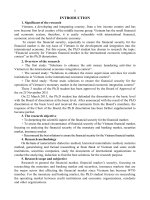Financial accounting in an economic context 8e chapter 05
Bạn đang xem bản rút gọn của tài liệu. Xem và tải ngay bản đầy đủ của tài liệu tại đây (533.53 KB, 47 trang )
1
Chapter 5:
Using Financial Statement
Information
2
Control and Prediction
Financial accounting numbers are
useful in two fundamental ways:
– They help investors and creditors
influence and monitor the business
decisions of a company’s managers.
– They help to predict a company’s
future earnings and cash flows.
3
Book Value vs. True Value
Financial statements do not reflect the
company’s prospects within its business
environment
– Statements are backward looking, not focusing
on the future prospects.
Financial statements are inherently limited
– Statements leave out some current and
historical information such as human
resources and the effects of inflation.
Management prepares the financial statements in
a biased manner
– Managers often choose accounting methods
and estimates that make them look good.
4
Framework for
Financial Statement Analysis
Book
BookValue
Value
Add
Addadjustments
adjustments for:
for:
(1)
(1)business
business environment
environment
(2)
(2)unrecorded
unrecorded events
events
(3)
(3)management
managementbias
bias
== True
True Value
Value
5
Five Steps of
Financial Statement Analysis
Assessing the business environment.
Reading and studying the financial
statements and footnotes.
Assessing earnings quality.
Analyzing the financial statements.
Predicting future earnings and/or cash
flow.
6
Assessing the Business
Environment
What is the nature of the company’s
operations?
What strategy is being employed to
generate profits?
What is the company’s industry?
Who are the major players? Competition?
What are the relationships between the
company and its customers and suppliers?
How are the company’s sales and profits
affected by changes in the economy?
7
Reading and Studying the Financial
Statements and Notes
Read the audit report.
Identify significant transactions
– major acquisitions, discontinuance or
disposal of a business segment,
unresolved litigation, major write-downs of
receivables or inventories, etc.
Read the financial statements and
footnotes.
8
Assessing Earnings Quality
Earnings quality may be affected by a
number of strategies managers use to
influence accounting numbers. Four
major strategies are discussed:
– Overstating operating performance
– “Taking a bath”
– Creating hidden reserves
– Employing off-balance-sheet
financing
9
Assessing Earnings Quality
Overstating operating performance
through the acceleration of recognition
of revenue - shift the timing of revenue
from a future period to the current
period, through legitimate or
questionable activities.
Overstating operating performance
through the allocation and estimation of
expenses - shift the recognition of
expenses through the use of “taking a
bath” and “creating hidden reserves.”
10
Assessing Earnings Quality
Taking a bath (also called “big bath”) - large
losses and expenses this year may increase
income in future years.
Rationale: if the current year is going to be
disappointing to investors anyway, increase
the loss to make next year look better. For
example:
– Excessive write-downs of equipment will
lead to lower depreciation expense in future
years.
– Excessive write-downs of inventory will
lead to lower cost of goods sold next year.
11
Assessing Earnings Quality
Creating hidden reserves - expenses
may be shifted from one year to another
year by overestimating expense accrual.
Excessive bad debt expense or warranty
expense in the current year will lead to
reduced estimates in future years, as the
“reserve” is used up.
Note that these “reserves” have nothing to
do with cash reserves; they simply reserve
some of the “income” to future periods.
12
Assessing Earnings Quality
Employing off-balance-sheet financing - this
relates to certain economic transactions that are
not reflected in the balance sheet.
Managers prefer to keep certain liabilities off the
balance sheet when GAAP permits it, primarily
because of potential debt covenant violations,
and because of the effect on certain ratios.
Examples include:
– treatment of leases as operating leases (Radio
Shack)
– unconsolidated investments (Enron’s
“partnerships”) which do not separate assets
from liabilities.
13
Analyzing the Financial Statements
Comparisons across time
Comparisons within the industry
Comparisons across different countries
Comparisons within the financial statements:
common-size statements and ratio analysis
–
–
–
–
–
Profitability ratios
Leverage ratios
Solvency ratios
Asset turnover ratios
Market ratios
14
Comparisons Across Time
Financial accounting numbers can be
made more meaningful if they are
compared across time.
GAAP require side-by-side comparison
of the current and the preceding years
in published financial reports.
15
Comparisons Within the Industry
Financial accounting numbers can also be
made more meaningful if they are compared
to those of similar companies.
Comparison of financial accounting numbers
with industry averages is also helpful.
Sources of industry information include:
– Dun & Bradstreet
– Robert Morris Associates
– Moody
– Standard & Poor
16
Common-Size Financial Statements
17
Comparisons Within
the Financial Statements
Common-size financial statements
Ratio analysis
– Profitability ratios
– Leverage ratios
– Solvency ratios
– Asset turnover ratios
– Market ratios
18
Common-Size Income Statement
for La-Z-Boy, Inc. (Figure 5-2)
Income Statement (in millions)
Net sales
2008
%
$1,227 100
Cost of sales
(888)
72
Expenses and charges
(460)
37
$ (121)
(9)
Net income
2007
%
$1,451 100
(1,057)
73
(408) 28
$ (14)
(1)
On the income statement, cost of goods sold,
expenses, and net income are often expressed
as percentages of net sales.
On the balance sheet, assets and liabilities can
be expressed as percentages of total assets.
19
Profitability Ratios
These ratios are designed to measure a
firm’s earnings power.
Net income, the primary measure of the
overall success of a company, is compared
to other measures of financial activity or
condition to assess performance as a
percent of some level of activity or
investment.
20
Profitability Ratios
Return on
Equity
Net Income
Average Shareholders’ Equity
This ratio measures the effectiveness at
managing capital provided by the shareholders.
21
Profitability Ratios
Return on
Assets
Net Income + Interest Expense (1-tax rate)
Average Total Assets
This ratio measures the effectiveness at managing capital
provided by all investors (stockholders and creditors).
22
Profitability Ratios
Return on
Sales
Net Income + Interest Expense (1-tax rate)
Net Sales
This ratio provides an indication of a company’s ability to
generate and market profitable products and control its
costs; also called the Profit Margin.
23
Leverage Ratios
Leverage refers to using borrowed
funds to generate returns for
stockholders.
Leverage is desirable because it
creates returns for shareholders without
using any of their money.
Leverage increases risk by committing
the company to future cash obligations.
24
Leverage Ratios
Common
Equity
Leverage
Net Income
Net Income + Interest Expense (1-tax rate)
This ratio compares the return available to the
shareholders to returns available to all capital providers.
25









